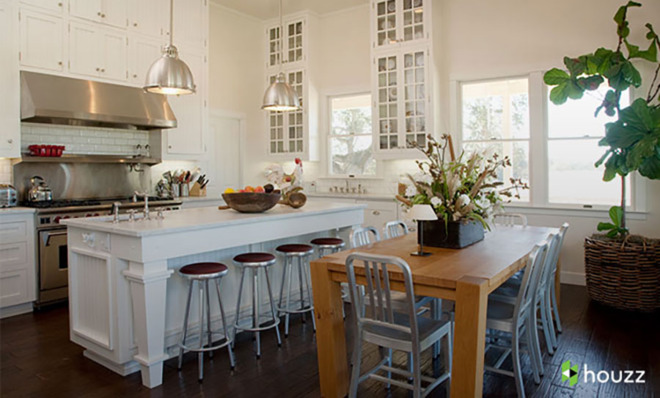9 exit strategies for your clutter
Let it go


Many of us have a problem with clutter. It can be so hard to get rid of things. Often the difficulty comes down to deciding whether something really is clutter. The struggle can be internal ("I could use this some day"), or with various family members ("Are you kidding me? That was my Aunt Agatha's!")
If you are desperate to clear things out of your house, a good place to start is the stuff everyone can agree needs to go. In our family no one wants to hold on to outgrown clothing, dead batteries, returnable bottles and cans, and books we've read but don't love enough to keep. So why can't we get them out of the house? Why are they piled by the door or on the end of the table, stashed in the back of the pantry or moldering in bags in the garage? Why!
I was thinking about this as we cleaned the garage last week, and then again when I unloaded a table outside our laundry room and noted the various bags of things I had carefully gathered and sorted and then forgot about for weeks on end. I realized we need to come up with a few systems for getting this stuff out of the house. We need some exit strategies.
The Week
Escape your echo chamber. Get the facts behind the news, plus analysis from multiple perspectives.

Sign up for The Week's Free Newsletters
From our morning news briefing to a weekly Good News Newsletter, get the best of The Week delivered directly to your inbox.
From our morning news briefing to a weekly Good News Newsletter, get the best of The Week delivered directly to your inbox.
1. Assess successful systems of removal. In our house the only system we have is trash and recycling. One big reason it works is they come to us. If only Goodwill did weekly pickups! But there were other things to notice and replicate: designated containers and a set date of removal.
(More from Houzz: 5 ways to pare down your stuff — before it gets in the door)
2. Identify what needs to go. Odds are it will come down to a few broad categories. In our house it's mainly items for Goodwill, children's outgrown clothing to go to consignment, books to trade for credit at our local bookstore, things to be returned to the store (for whatever reason!), library books, and dead batteries.
3. Designate bags or boxes for removal. We have a bag for library books, but I use paper grocery bags for Goodwill or the bookstore. Only sometimes do I label them, which requires double checking and makes it impossible for my husband to make a run to Goodwill without my oversight.
A free daily email with the biggest news stories of the day – and the best features from TheWeek.com
Contemporary Other by Brooklyn Furniture & Accessories West Elm
For the books, I'm going to buy a couple of canvas bags: one to hang on a hook in the mudroom and one to sit on the table outside our laundry room.
4. Establish where the designated bags live between returns. Not all of us have roomy pantries, mudrooms, or garages. We may need to keep our bags out in the open, which isn't such a bad thing — because out of sight is often out of mind.
(More from Houzz: Get organized with new storage products)
Attractive bags or baskets are nice, but function needs to come before form. Get your system in place first, and cute it up as you go.
Bonus: Do you have family or friends who frequently visit and forget things? We have a bag hanging in our front closet specifically for my sister's family. When anything is forgotten or we come across something we want to give them, it goes into the bag.
5. Create a schedule of purging. It's natural in fall and spring to go through clothing and decide what no longer fits. Choose a day, bag things up and get the bags out of the house. So easy to type but so many steps — I know!
Short term, it could be designating a day every week or two to run errands, including stops at the library, Goodwill or shops to make returns.
6. Always carry a basket. For a while I kept the habit of carrying a medium-size basket in and out of the house. It lived by my back door or sat in the front seat of my van. It got me thinking what I needed to take with me and what I needed to remove from my van. This would need to be modified if you don't use a car, but the most important thing is establishing routines for removal.
(More from Houzz: Eliminate clutter with the help of an organization pro)
7. Assign a responsible party. Unless you live alone, creating exit strategies needs to be a group effort. One person may be the main curator/gatherer and another can be in charge of removal, but it probably won't be neatly divided. Trial and error will help you figure out what works (or doesn't) in your household.
8. Start small. Work on one habit at a time. What's driving you the most batty is a good place to start.
9. Refine and tighten things as you go. Perhaps you already have some successful systems in place and you just need to work on details. Be patient, keep working on things and watch success build upon itself.
Houzz helps you renovate and design your home from start to finish, whether you’re decorating a small room or building a custom home and everything in between. Get started!
-
 5 sleeper hit cartoons about Sleepy Don
5 sleeper hit cartoons about Sleepy DonCartoon Artists take on cabinet meetings, a sleepy agenda, and more
-
 Political cartoons for December 6
Political cartoons for December 6Cartoons Saturday’s political cartoons include a pardon for Hernandez, word of the year, and more
-
 Pakistan: Trump’s ‘favourite field marshal’ takes charge
Pakistan: Trump’s ‘favourite field marshal’ takes chargeIn the Spotlight Asim Munir’s control over all three branches of Pakistan’s military gives him ‘sweeping powers’ – and almost unlimited freedom to use them
